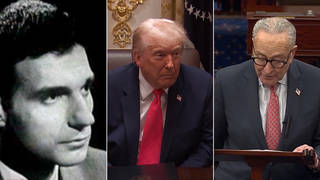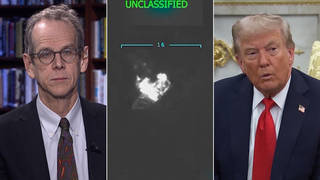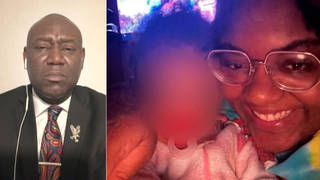
Clifford Owensby says Dayton police violently arrested him last month even though he is paraplegic and repeatedly told them he could not use his legs to get out of the car during a traffic stop. New police bodycam video shows the officers dragging Owensby out of his car and yanking him by his hair as he shouted for help. Owensby had his 3-year-old child in the car at the time of arrest. He has now filed a complaint with Dayton’s branch of the NAACP. “The officers should be placed at least on administrative leave,” says Derrick Foward, president of the Dayon Unit NAACP. Foward says that Owensby is expected to bring a case against Dayton police once all the evidence is collected, and he attributes the quick release of the bodycam video to recent police reforms advocated for in the wake of the murder of George Floyd.
Transcript
AMY GOODMAN: We begin today’s show in Dayton, Ohio, where the NAACP is denouncing the violent arrest of a Black man who’s a paraplegic and repeatedly told police officers he could not use his legs. A warning to our audience: This story includes disturbing images and descriptions of police violence.
During a September 30th traffic stop, Dayton police officers stopped Clifford Owensby’s car after they said it was seen leaving a suspected drug house. Police body-camera footage released Friday shows the police officers telling Owensby to exit his car so a police dog could conduct an “air-sniff” search. Owensby told them he could not step out of the car because he’s a paraplegic. This is part of their exchange.
POLICE OFFICER 1: Yeah, I’m going to need you to step out of the car.
CLIFFORD OWENSBY: I can’t step out of the car, sir. I’m a paraplegic. I got help getting in.
POLICE OFFICER 1: I’ll help you getting out.
CLIFFORD OWENSBY: Excuse me?
POLICE OFFICER 1: I’m going to help you getting — get out.
CLIFFORD OWENSBY: Well, I don’t think that’s going to happen, sir.
AMY GOODMAN: When the officers said they would help Owensby get out of the car, he said, “I don’t think that’s going to happen, sir.” He used his cellphone to call for help, repeatedly requesting a supervising officer, a “white shirt,” as officers commanded him to get out of the vehicle.
CLIFFORD OWENSBY: I cannot step out of the car. I cannot step out of the vehicle.
POLICE OFFICER 1: You got in the car. You can get out of the car.
CLIFFORD OWENSBY: Hello? Hey, bro, can you come down the street to Ferguson and Grand? The police just pulled me over, and they’re trying to make me get out of the car, and I’m telling them I’m a paraplegic, I can’t get out of the car without no help [bleep]. They also [bleep]. Just come down the street. Bring some people with cameras. Come down the street. Come bring cameras and bring — just bring somebody so they can witness what’s going on.
POLICE OFFICER 1: All right, come on. Time to get out of the car.
CLIFFORD OWENSBY: I’m not getting out. I just told you. I’m a paraplegic. I cannot get out.
POLICE OFFICER 1: I do not want to have to — I don’t what to have to take you out.
CLIFFORD OWENSBY: Can you call your white shirt, please?
POLICE OFFICER 1: I will, once —
CLIFFORD OWENSBY: If you pull me out of here, you better expect [inaudible] —
POLICE OFFICER 1: Here’s the thing: I’m going to pull you out, and then I’ll call a white shirt, because you’re getting out of the car. That’s not — that’s not an option. You’re getting out of this car! So you can cooperate and get out of the car, or we’ll drag you out of the car. Do you see your two options here? I wish — what would you like to do, sir?
CLIFFORD OWENSBY: I know I got rights. I would like you to call your white shirt.
AMY GOODMAN: Owensby is calmly in the car but says simply he cannot move. Police bodycam video then shows officers dragging Clifford Owensby out of his car, yanking him by his hair, flipping him on his stomach and handcuffing him as he screams and shouts for help. The officers then drag Clifford Owensby to their police car.
POLICE OFFICER 1: Get out of the car.
CLIFFORD OWENSBY: You’re hurting me, bro!
POLICE OFFICER 1: Get out of the car. Get out of the car.
CLIFFORD OWENSBY: What are y’all doing, bro? I’m a paraplegic, bro.
POLICE OFFICER 2: Get out of the car, dude. You’re making this worse.
CLIFFORD OWENSBY: I’m a paraplegic, bro!
POLICE OFFICER 1: Get out of the car. Get out of the car.
CLIFFORD OWENSBY: I’m trying to tell you that I got help getting in the car. You’re [bleep] hurting me!
POLICE OFFICER 1: Get out of the car.
CLIFFORD OWENSBY: You’re hurting me!
POLICE OFFICER 1: Get out of the car.
CLIFFORD OWENSBY: Ow, bro! I’m a paraplegic! Ow!
POLICE OFFICER 1: You had a chance to get out of the car. You resisted the cops.
CLIFFORD OWENSBY: Ow! Ow! Ow!
POLICE OFFICER 1: Get out of the car.
CLIFFORD OWENSBY: Somebody help! Somebody help! Somebody help!
AMY GOODMAN: Clifford keeps shouting, “Somebody help!” Officers also removed a 3-year-old child from the backseat of the car. Clifford Owensby was not charged with any drug-related offenses. He has now filed a complaint with the Dayton, Ohio, Unit of the NAACP. At a news conference Sunday, he described the assault.
CLIFFORD OWENSBY: They did not find any weapons, guns or drugs. They did find my money, which they took. I don’t see where I did anything wrong in this matter. And I am lost for words for what they did to me. It was totally humiliation. It was hatred at its purest fashion. I have never seen or witnessed anything in my life. … If they was caught doing this on camera, I can only imagine what would have happened if the cameras weren’t rolling. I felt like they kidnapped me and they was going to hold me for ransom. Everything that they did to me reminds me of what I used to watch on TV, the movie Roots. It was total slavery. I felt like they was trying to catch a slave. And they was threatening to tase me and all of that because I was crying out for help, Taser being the whip. And I keep getting whipped and whipped over and over every time I keep thinking about it. Every time I hear about somebody sharing that video, it is a constant reminder. I believe those cops need to be prosecuted to the fullest extent of the law. It is unfair that we have cops like that out here patrolling these streets in America.
AMY GOODMAN: That’s Clifford Owensby speaking through a face mask on Sunday at a news conference.
For more, we go to Dayton, Ohio, to talk to Derrick Foward. He’s president of the Dayton Unit of the NAACP, who was sitting next to Clifford Owensby at that news conference announcing he’s suing police for profiling him, unlawful arrest, illegal search and seizure of his vehicle.
Welcome to Democracy Now!, Dr. Derrick Foward. It’s great to have you with us, but not under these circumstances. Can you explain more what exactly took place?
DERRICK FOWARD: Yes. Thank you for having me on this morning to continue to discuss our client’s case, Mr. Owensby, Clifford Owensby.
I can tell you that according to his account of what has taken place, and if we match it up with the video footage that we have been able to obtain, here is how things occurred. Owensby left home that morning to go take his children to school. He went back home after dropping a couple of his kids off to school, because he has seven children, so he has a pretty big family. Then he went, proceeded and remembered that he needed to go and pick up some cable boxes from one of his tenants. So he went back out, and he went to the home of where one of his tenants live, which is his property, to pick up the cable boxes. They brought the cable boxes out to his vehicle, and he proceeded to leave the property. So, at that time, he later started driving, and, shortly after that, the police turned their sirens on and pulled him over.
And I want to be very clear here: From the start until the finish, our client was very compliant. Because it seems like that’s a sticking point in what the officers are trying to say. So, they pulled him over. So that’s compliancy number one. Turned their sirens on, and they pulled him over. He is compliant.
Next thing they ask him to do is roll his windows down, to roll some of his windows down so they can test his car for tint to see whether or not the tint was too dark. Ultimately, what they really truly did was a pretextual stop, because they had — they thought that they were going to find drugs. They thought that they were going to find weapons. They thought they were going to find something illegal. So, this stop about windows was a precursor to what they were really leading and wanting to do. So, at that point in time, they test his windows. They told him that his windows were too dark. Of course, they go back to his car. They run his name, see that he had prior weapons and/or drug charges stemming back from 2008. And here it is we’re 2021.
So, they came back to the car, so compliancy number two would be that they asked him to turn his car off. He turned his car off. But in his mind, he’s wondering, “Well, why am I turning my car off?” Really, he’s thinking that he’s going to be getting a ticket, a citation for windows, for his tint being on his windows. And so, with that being said, you know, he wanted him to stop his car.
Then, after that, the officer, of course, asked him to get out of the car. He explained that he was a paraplegic. He does not really truly have utilization of his legs. In fact, I know that when he came to our office a couple of times, one of my security staff helped him back in his vehicle, and I helped him in his vehicle the second time. So I know that he does not really have utilizations of his legs.
So, with that said, when the police officer said that he would help him out, at this point in time, the police officer, in our client’s purview, was aggressive. His tone had changed. So, really, he became afraid of that particular officer. And that’s why he asked for a white shirt. And if you can hear it clearly on the video, he asked for a white shirt several times. And then the officer ultimately said he would call a white shirt once our client stepped out of the vehicle and/or be pulled out of the vehicle.
So, that is the narrative. He was stopped, a pretextual stop. He was compliant, number one, from the stop. Woop! He pulled over. He complied. Number two, turn your car off. He complied. Number three, at this point in time, after they done ran his record and they’re telling him that they need to check his car and get a dog because of his prior conviction from 2008, that had nothing to do with the initial stop. And that’s where it becomes very problematic.
So, then, when you take a look at the case pursuing, so then he said, “Well, you’re not going to be able to pull me out, sir. I’m a paraplegic.” And he kept explaining to him that he’s a paraplegic. Well, as you can hear clearly on the video, the officer said, “There’s only one or two ways — only one or two things that’s going to happen. You got options. You got two options, in fact: Either we’re going to pull you out, or you’ve got to get out.” Well, you know that he wasn’t going to be able to get out, because he can’t just get out of the vehicle like that. So the officer chose the latter — the officers, at that point in time, chose the latter, to pull him out.
And as they’re pulling him out, they unbuckled his seatbelt. You’ll be able to see that very clearly in the video. They unbuckled his seatbelt. And then, after that, they commenced to pulling him out. He was scared for his life, so he held onto the steering wheel and closed his eyes, according to his account. And he was afraid of what was going to happen, so that’s why he closed his eyes and just held onto the steering wheel. So, at that point in time, they were able to snatch him out of the car.
JUAN GONZÁLEZ: Well, Dr. Foward?
DERRICK FOWARD: Yes.
JUAN GONZÁLEZ: Dr. Foward, I wanted to ask you, one: Have the officers involved been identified at all? Because they must have filed incident reports, even if they didn’t arrest him. And also, the release of the video: How was the video obtained? Because this incident happened on September 30th, so it’s actually pretty — not too long since it happened that the video has been released. What was the process of getting the video made public?
DERRICK FOWARD: Well, the police department, they went through whatever details they wanted to go through. And, you know, after that, they did a briefing, I guess, with the city commission, and then they released the video. So, I guess they wanted to make certain that they had their ducks in a row to create their narrative about why they stopped him, what happened in terms of him being pulled out of the vehicle.
So, yes, you bring up a good point, the time lapse of release of the video. And that’s part of the Dayton Unit NAACP eight-point strategy that we implemented with 21 different law enforcement agencies throughout Montgomery County, Ohio, after the death of George Floyd. We started — we actually assembled 20 — well, I mean, 18 different partners that we have, and we came up with an eight-point strategy on criminal justice reform and police accountability. That can be found on our website, on the front page of our website, if anyone cares to look at it. So, part of that is training officers. Part of that is to be able to release footage immediately. You know, so, you’ll be able to look at our eight-point strategy, and these are things that we tried to implement.
The city of Dayton did assemble — if you’re not aware, the city of Dayton did assemble five working groups to look at police reform itself. And I commend them for doing that. And, in fact, several of my leadership — members of my leadership team actually sat on each one of those working groups to help implement parts of our eight-point strategy in the recommendations that the city released. There was142 recommendations that the citizenry, that the full scope of the city of Dayton, so you had citizens involved, you had police department involved, you had business community involved, you had the faith community involved. It was a cross-segment of various community stakeholders that they assembled, five working groups. And with that, they have — I think they have implemented maybe about 30 of them currently, somewhere along that road, out of 142. So we have a long way to go inside of the city of Dayton in terms of police reform. But let me continue on —
JUAN GONZÁLEZ: And, Dr. Foward — Dr. Foward, I wanted to ask you about another case that happened earlier this year, a very similar type case. Could you talk about the case of Jack Runser —
DERRICK FOWARD: Jack Runser.
JUAN GONZÁLEZ: — the 50-year-old man who is deaf, mute and has cerebral palsy and now is the subject of misconduct complaints against the police?
DERRICK FOWARD: Yes. So, Jack Runser also filed a complaint at our office, kind of — to your point, kind of a similar situation. Jack Runser left his house. He has cerebral palsy. He’s deaf. He’s mute. And he was walking up the street. And really, it’s a cross-blend of this particular case, our current case, along with the John Crawford case, and you’ll see why here in a minute. So, in this particular case, Runser is walking up the street, walking up Gettysburg to — I think it’s a Family Dollar on the top of the hill at Gettysburg and Germantown. Well, someone called in, just like someone called in on John Crawford. Someone called and said that it appeared that this man was drunk walking up the street, or he was high or whatever the case may be. So, the police officers, when they met him inside the parking lot of his destination, they basically took the callers at face value — what the callers called it, at face value, the same way out in Beavercreek that they did with John Crawford, at face value, instead of reassessing the situation.
So, we called upon our law enforcement agency, the Dayton specifically in this particular case, to look at a way to deal with people with disabilities, mentally ill people, when making stops. So, from our perspective and from our client Runser’s perspective, he was abducted from the location of where he was going to just get some snacks. Because the police could not communicate with him, they also thought that he was high, so they took him to the hospital. They took him to the hospital. And then, from there, thank God that one of the doctors knew him, knew Runser, and they told him that Runser is mute and he has cerebral palsy. So, Runser tried to ask them to take him back to where they picked him up from. The officers didn’t do that. So there’s a lack of empathy, lack of training. And he had to call somebody to pick him up from the hospital.
AMY GOODMAN: Dr. Foward, before we end, I wanted to ask you, back on this case — and, of course, you’re referencing John Crawford, who was the African American man, 22 —
DERRICK FOWARD: We had that case, as well.
AMY GOODMAN: — years old in 2014, shot dead by police in a Walmart as he shopped. But I wanted to ask you, in this case: At this point, has Clifford Owensby sued the police? And I understand that the officers —
DERRICK FOWARD: No.
AMY GOODMAN: — the white officers involved, they’re still on the job during the investigation?
DERRICK FOWARD: Yes, we feel that the officers should be placed at least on administrative leave or desk duty. We do not feel that officers who cannot control their tempers need to be on the street.
And secondly, to your first question about has he sued the Dayton police officers, that has not yet happened. But I would say that when he gets with his lawyers — he does have a legal team. I have been in conversation with his legal team. And I’m quite certain that time will tell what’s going to happen in that particular case, once all the evidence is collected. So, when you conduct any investigation, you want to make certain, whether or not you’re a police department and/or whether or not you are a lawyer representing someone, you want to make certain that you gather all of the facts. And then you evaluate the facts, and then you pursue the destination that you want to pursue.
AMY GOODMAN: Dr. Derrick Foward, we want to thank you for being with us, president of the Dayton Unit of the NAACP.
Next up, we go to Iraq, where the populist Shiite cleric Muqtada al-Sadr, who has opposed the U.S. occupation for years, won the biggest gains in Sunday’s parliamentary elections. Stay with us.












Media Options